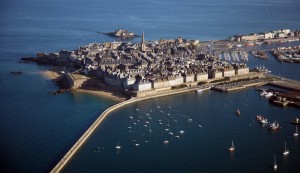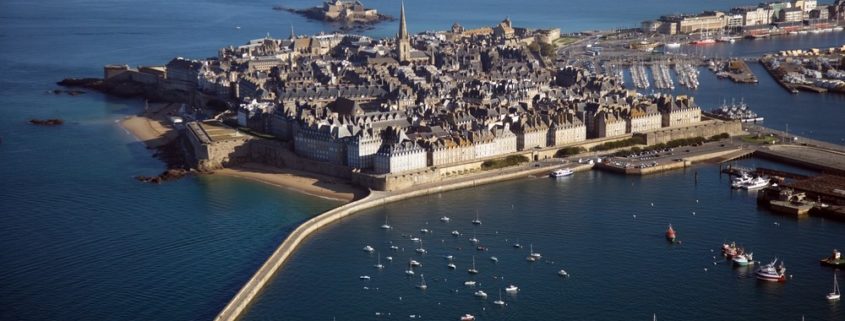St Malo and Dinard
St Malo’s main attraction is its citadel, known as Intra Muros (within the walls), faithfully restored after destruction by bombs in 1944. Towering walls frame inviting glimpses of the elegant shopping streets and outdoor cafés within. Many of the streets are quite steep and paved with large cobbles.
 You can walk around the ramparts, originally constructed in the 14th century, with views of the sea on one side and the old town on the other. Pass through one of the gaps to cross the causeway to the island of Grand Bé to see the tomb of the writer Chateaubriand (1768-1848) and for great views of the islands, the mainland, the mountains and Dinard.
You can walk around the ramparts, originally constructed in the 14th century, with views of the sea on one side and the old town on the other. Pass through one of the gaps to cross the causeway to the island of Grand Bé to see the tomb of the writer Chateaubriand (1768-1848) and for great views of the islands, the mainland, the mountains and Dinard.
Children are likely to enjoy this walk as there are rocks to clamber on and pools to explore. Don’t get stranded by the tide: If you do, there’s a six-hour wait before you can walk back! Sights in the Intra Muros district include the Cathédrale St-Vincent, with its modern stained-glass window and diamond-shaped mosaic commemorating Jacques Cartier’s interior exploration of Canada in 1535. The aquarium concealed in the ramparts has an extraordinary range of tropical fish.
The Musée d’Histoire Château de St-Malo, within St-Malo’s old castle, has some fascinating exhibits. On the second floor, look out for the carved figurehead destined for the prow of a corsaire vessel, depicting a 17th-century sailor. One room describes the life of St-Malo fishermen in Newfoundland. Another floor deals with great men of St-Malo, including the naval commander Robert Surcouf (1773-1827) and the ubiquitous Chateaubriand.
Dinard occupies a rocky outcrop across from St-Malo and has several small but sandy beaches. High tides and regular sea breezes provide excellent yachting conditions, and the tempering effects of the Gulf Stream encourage lush subtropical vegetation.
Dinard was a typical Breton fishing port until the 19th century, when it was discovered by the American and British richer classes. During the Belle Époque it was the place for yachting, gambling and other upper-class leisure activities. Today it is an upscale resort, popular with French visitors.
The Plage de l’Écluse, with its distinctive blue-and-white striped cotton beach huts, is the largest beach. Overlooking it is the Casino Barrière du Dinard, in boulevard Wilson, and nearby is an Olympic-size, covered, heated-seawater swimming pool and the modern Palais des Arts et Festivals. A public footpath, the Chemin de Ronde, leads along the coast. The central section, from Plage du Prieuré in the south to the Pointe du Mulinet, is called Promenade du Clair de Lune and is popular for an afternoon or evening stroll.
More visitor information on St Malo can be found on our Brittany pages.




Leave a Reply
Want to join the discussion?Feel free to contribute!